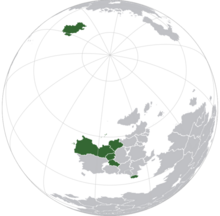Samorspi
This article is incomplete because it is pending further input from participants, or it is a work-in-progress by one author. Please comment on this article's talk page to share your input, comments and questions. Note: To contribute to this article, you may need to seek help from the author(s) of this page. |
Samistopol Cooperation Organisation
| |||||||||||||||
|---|---|---|---|---|---|---|---|---|---|---|---|---|---|---|---|
|
Flag | |||||||||||||||
| Motto: Вперед, разом. Forward, together. | |||||||||||||||
 | |||||||||||||||
| Capital | Samistopol | ||||||||||||||
| Largest cities | Samistopol, Paltamo, Drosnja | ||||||||||||||
| Official languages | |||||||||||||||
| Type | Economic union and military alliance | ||||||||||||||
| Member states | |||||||||||||||
| Leaders | |||||||||||||||
• SCO Executive Chairperson | |||||||||||||||
• TMA Executive Secretary | |||||||||||||||
| Establishment | |||||||||||||||
• Treaty of Maljubav | 20 October 1983 | ||||||||||||||
• Treaty of Samistopol | 17 June 1989 | ||||||||||||||
| Area | |||||||||||||||
• Total | 3,785,027 km2 (1,461,407 sq mi) | ||||||||||||||
| Population | |||||||||||||||
• 2018 estimate | 141,514,270 | ||||||||||||||
| GDP (PPP) | 2018 estimate | ||||||||||||||
• Total | $4.36 trillion | ||||||||||||||
• Per capita | $30,809 | ||||||||||||||
| Time zone | UTC+13 to UTC+0 | ||||||||||||||
The Samistopol Cooperation Organisation, often abbreviated to the SCO or Samorspi from its Narodyn translation, is a political, economic and military alliance as well as a regional intergovernmental organisation consisting of the four modern states of the Empire of Narozalica as well as Gibany and Piraea. Most member states of Samorspi are closely aligned to Narozalica either economically, politically or militarily, with the bloc aiming mainly to promote economic and military collaboration and cooperation between its member states. As of 2018, Samorspi has an estimated population of over 141 million and a GDP of over $4 trillion, around 70% of which is made up by Narozalica. Samorspi has been described as the main competition to the Euclean Community in Euclea.
Samorspi was established originally in 1983 with the signing of the Treaty of Maljubav in Maljubav, Minilov, between delegations from Narozalica, Minilov, Vedmed and Velzemia to promote cooperation between the four states. With large economic boosts seen in all countries due to intranational investment and economic cooperation, Samorspi was consolidated into an intergovernmental organisation by the Treaty of Samistopol, signed in 1989. Samorspi expanded in 1996 with the accession of Gibany and Piraea to the organisation. The Tsivebi Military Agreement was signed in 1997 to established a military alliance between Samorspi member states, however members are permitted to opt out of the TMA, which Piraea and Velzemia exercised in 1998.
While smaller than the Euclean Community, Samorspi still exerts a powerful influential role on the international geopolitical stage, especially through Narozalica in the role of defense. Samorspi has central leadership through the SCO Executive Chairperson, currently Velzemian politician Marija-Liisa Kulmala, and the TMA Executive Secretary, currently Narozalic military officer Artem Koneneko.
History
Treaty of Maljubav
Treaty of Samistopol
Tsivebi Military Agreement
Governance
Foreign relations
With the EC
Economy
Member states
| Nation | Population | SCO Delegation | GDP | GDP per capita | Date of accession |
|---|---|---|---|---|---|
| 11,329,605 | Valentin Besic | $265 billion | $23,375 | 1996 | |
| 6,201,783 | Orlov Yanovich | $284 billion | $45,806 | 1983 | |
| 89,142,866 | Vladimir Mlynár | $3,028 billion | $33,971 | 1983 | |
| 7,249,810 | Vasilios Demotis | $207 billion | $27,664 | 1996 | |
| 10,578,243 | Erekle Toreli | $328 billion | $31,078 | 1983 | |
| 17,013,556 | Marija-Liisa Kulmala | $276 billion | $16,228 | 1983 |
